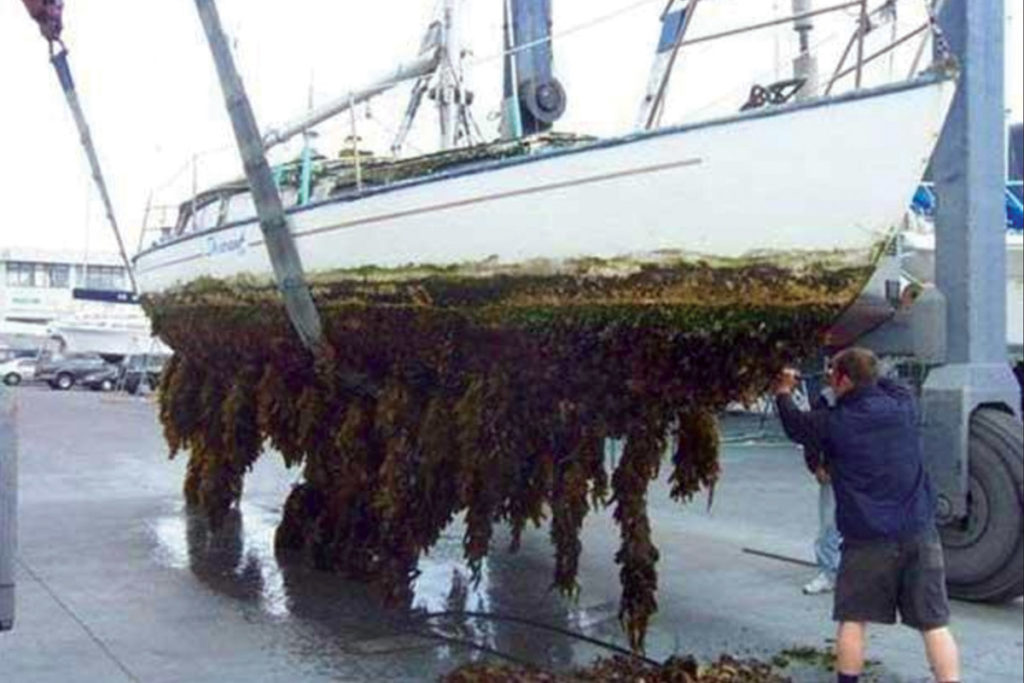My name is Chris Schmokel, and I am an environmental chemistry major at Oregon State University and also an Oregon Sea Grant Summer Scholar Fellow. My fellowship placement is with the Oregon DEQ, and this summer I’m working on two projects: starting up a pilot program to test for copper concentrations in Oregon waters, and creating a short video to share all the good work being done by the Oregon Sea Grant’s Oregon Applied Sustainability Experience internship program.
Some background on the copper testing project:

Organic growth on the underside of boats is known as fouling, and it can range from a mild inconvenience to a major problem, depending on how long a boat is in the water and the type of aquatic organisms present at a given location. Many techniques have been developed over the years to deal with this problem, but currently the most prevalent solution is the use of special antifouling paint for the undersides of boats. This paint contains a large percentage of copper, which acts as a biocide, slowly leaching into the water adjacent to a boat and discouraging organisms from attaching to it. Unfortunately, copper ions released in this way can spread beyond a boat’s immediate vicinity, and can cause unintended ecological harm. A great deal of research has shown that excessive copper concentrations are toxic to many types of aquatic organisms, including freshwater mussels and salmonids, among others. Both California and Washington have passed regulations to control the use of copper based boat paint, but Oregon has yet to do so. My project for the summer will focus on developing a pilot water testing program to help the DEQ get a better picture of the concentrations of copper at various sites around Oregon. This sort of testing may be the first step towards Oregon enacting copper regulations similar to its neighboring states.
My second project this summer is creating a short video to highlight the work of the Oregon Sea Grant’s Oregon Applied Sustainability Experience internship program. This program partners college students with local businesses to find ways to improves efficiency and prevent waste and pollution. Tomorrow morning at 4:30 AM (!!!) I’ll be hopping in my car and heading down to Port Orford to get some shots of the halibut boats coming in to offload their catch. I’ll also be sitting down with intern Connor Nolan to talk about the work he’s doing with Port Orford Sustainable Seafood to reduce processing waste and maybe even convert it into a marketable product in the form of fish paste for cooking.
I’m very excited about these projects, and I hope next time I post I’ll have some fun photos from Port Orford, as well as some new information on a copper testing pilot program.



I hope your travels went well, Chris! It sounds like you are going to be doing some pretty important work. I look forward to your reading about your updates throughout the summer! It would be interesting to learn about some alternatives to the copper-based paint at some point. Good luck with your project!
Chris! So excited to read you are working with OR DEQ. Maybe we will be coworkers again. I start in September!
I was wondering what time you needed to leave to make it to Port Orford at a decent hour…Hope you had a safe trip and learned a bit about small-scale seafood processing. I bet those Halibut were mighty impressive!
Hi Chris! Thanks for the post – I thought it was fascinating. When I was an undergraduate, part of my job as a research assistant was to monitor the fouling communities at a static immersion test site in Morro Bay, CA. We would cover experimental anti-fouling paint on PVC plates to see what compounds were the best anti-fouling guards. Do you know what some of the specific negative effects of elevated copper in seawater are on marine organisms? Can’t wait to hear updates about your experimental design.
Hi Mary! How great that you’ll be starting up at ORDEQ! That would be so great to work with you again, and I hope you’re having an amazing summer!
Hi Megan! From what I’ve been able to tell, copper affects marine organisms in two ways: it disrupts the functioning of sodium-potassium channels in epithelial cells which can lead to a dramatic loss of sodium throughout the organism, and it can also reduce oxygen molecules within cells, forming oxygen radicals that react uncontrollably with essential cellular molecules and cause cell death.
Hi Sarah! Yes, it was great to see that Halibut coming in, and Port Orford is such a beautiful place too!
Hey Lucas! Thanks, glad you like the posts, I’ve been enjoying yours as well. From what I’ve learned, alternatives to copper based paint are problematic. One route is to use a super-slippery paint that doesn’t allow anything to stick to it, like a Teflon pan. The problem is that most of these paints use fluorinated compounds which are pretty nasty and stick around in the environment for a long time. Another alternative is to use a different biocide in the paint, but that has problems too: Most of the biocides that are used are much more toxic than copper, but are supposed to break down very quickly in aquatic environments. However, a lot of research has shown that these compounds don’t break down as much as was though in real-world situations.
Right now, there doesn’t seem to be many good alternatives to copper!